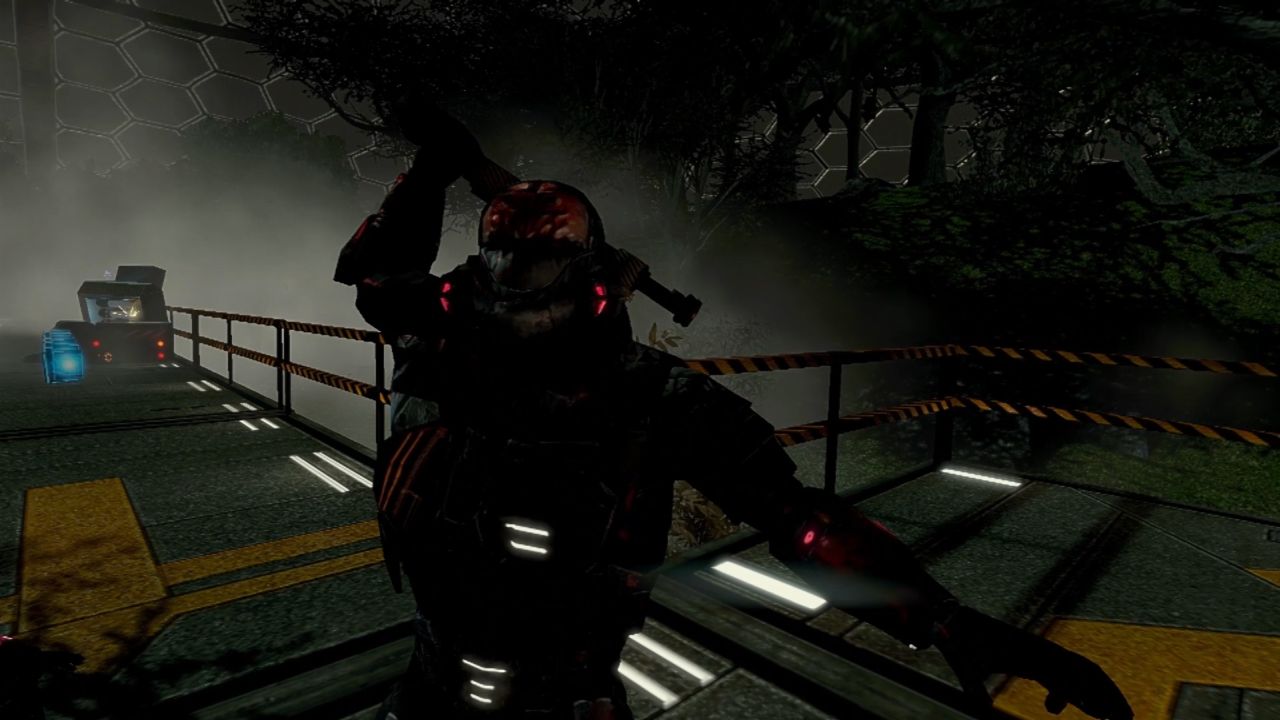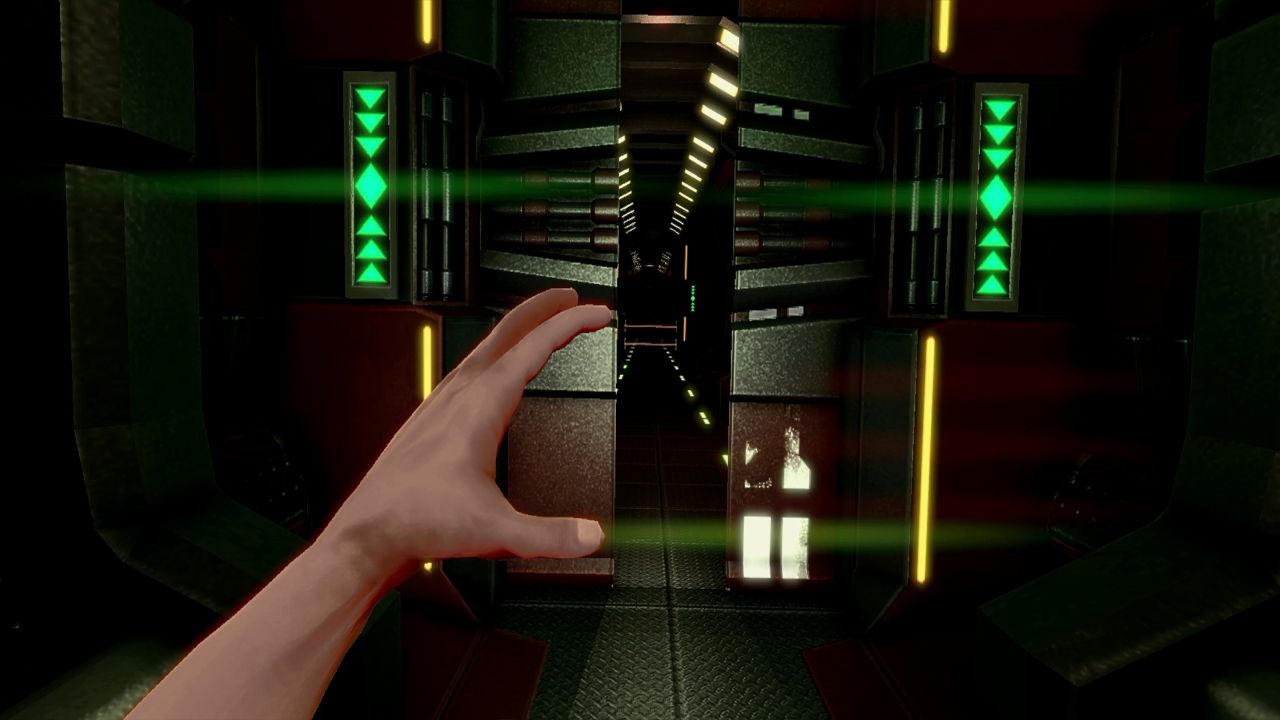Infinity Runner Review
Soon to become a running joke
How do werewolves fit into all this, though? With all the grace and elegance you'd expect from a European gothic-horror trope being inexpertly shoehorned into a generic sci-fi, that's how. Every now and then, during the Story Mode, the game places an unavoidable power-up in your path which forces you to transform. Your nails lengthen into claws, you hit all-fours, the screen goes red... and then things basically carry on as before, only slightly easier. You no longer have to pass any QTEs when you encounter a roomful of soldiers – although you still have to go through a lengthy kill animation, so I don't know what the bloody point is aside from subtracting even more gameplay from this already bleak serving – and you get a new obstacle based around wall-running, a technique just as stiff and inorganic as everything else thus far. Also the game resets your field of view back to the default of sixty – independent of what you had previously set it as – whenever you turn back into a human, but apparently I'm the only person who still cares about that. How can you make a game about werewolves in space and then make the 'werewolf' part so insignificant? It would be like making a Deus Ex sequel where acquiring augmentations just made your HUD slightly fancier and shaved a second off the time it took you to hack things.
Amazingly, the wall-running isn't even the game's most annoying obstacle. Infinity Runner was apparently developed using a test group of precogs who can sense their imminent frustrating death before it happens and avert it accordingly. While there are a lot of obstacles that you can see coming from a mile away, there are several which have an extremely short timespan between making themselves apparent and killing you, meaning that the only really viable strategy is to memorise their location and act before they've even appeared on-screen. The absolute pinnacle of this is in the final level, in which – spoiler alert – another werewolf hunts you down through a bio-dome complex, jumping out at you with a suddenness that I have come to associate with certain YouTube personalities screaming like they've plunged their hands into boiling oil. Ah, maybe that's it. Is this what you call viral marketing, Infinity Runner?

At least you can see those particular obstacles coming, though, even if it's just for a fraction of a second. I'd like to take a moment to mention that I really like the game's aesthetic in a lot of places – dark utilitarian sci-fi, the sort where fluorescent tubes never go out of style and metal tread-plates are everywhere – but I only allow aesthetics to encroach their grubby fingers so far upon gameplay's half of the table before I bring the steel ruler down on them. Some parts of the game are so dark that it's hard to tell what's rushing up to meet you until your face has been reshaped to resemble a novelty tea tray, and there are several points throughout the story when the game actually has the gall to deliberately shut the lights off for about half a level. All this might seem fairly insignificant – I mean, I can probably count the number of unfair hazards on both hands – but I find it doesn't gel well with the game's death mechanics. Just about everything is a one-hit kill, even obstacles that arguably should only give you a nasty lump on the head, and while there is a checkpoint system in place, its only real purpose is to lend meaning to the lives system. Getting close to the end of the level only to lose your last life to something you couldn't have possibly seen coming is something that would have ensured a broken controller or two once upon a time, and our amazing futuristic graphics (or, in this case, moderately acceptable graphics that look alright as long as you don't slow down) have not done anything to soothe this universal source of frustration.
And what motivation did I have to spur me past these moments of frustration? I suppose there was a story of sorts being fed to me. Obviously a game like this doesn't have much room for anything that could potentially distract you from the ten to twenty meters of floor space currently in your field of view, so the storytelling is restricted to a few voice-overs and a short televised monologue being delivered to you by your psychic guide at the end of every level. This doesn't necessarily disqualify the story from being an engaging rollercoaster of a narrative – heck, Portal managed to work wonders with less – but you can see where difficulties might arise. The real problem, what with the game's brevity, is that there isn't so much a story as a goal that gets shoved back every time you're about to achieve it: getting off this ship. Oh, there's a bit where a big mutant werewolf breaks your stride – who I think is supposed to be the primary antagonist, but hardly becomes a threat until really late in the game – and there's an escape pod ride that doesn't go particularly well, but ultimately all it does is put another meaningless barrier in the way of an equally meaningless goal, so your brain will probably file it all under 'to be discarded'.

It doesn't help that there's definitely something very naff about your psychic friend, whose name – Riley – just returned to me after about five minutes of drumming my fingers on the desk. It's not that her dialogue lines are badly-written, because 'badly-written' implies some glaring flaw that makes them stand out. These dialogue lines are the mushy peas of dialogue lines, completely without flair or flavour. In circumstances like these, you might have pre-emptively guessed that the voice acting is at fault, but it isn't bad either, at least not in the usual sense where it sounds like the actor's recent nose-picking expedition made them forget what inflections mean. In this case the voice actress sounds fine, but I just can't associate her amicable, conversational, matter-of-fact tones with the sneering Shadowrun cosplayer I see on the screen. Both she and her lines are just incongruously casual for an absurd sci-fi like this. That's not the voice of a psychic fugitive; that's the voice of a daily commuter chatting on the bus.
In truth, though, most of this review has just been an excuse to work all my petty complaints out of my system. The real problem with Infinity Runner is simple and universal: it's painfully repetitive. After only a few minutes everything begins to bleed together; an endless parade of identical corridors, pre-fabricated sequences, and kill animations. All the way through, the game is nothing more than the same infinite runner dressed up in a sequential line-up of new trousers, and when you finally exhaust its reserve of content – a task that can probably be accomplished in two or three hours, incidentally – there's nothing left to do but fruitlessly chase scores in the Arcade Mode. There's no expansion of the concept whatsoever; this is Temple Run with more bugs and a tacked-on story that would embarrass a Saturday morning cartoon. So here's the question, reader: would you pay ten dollars for Temple Run?
 Comments
Comments















